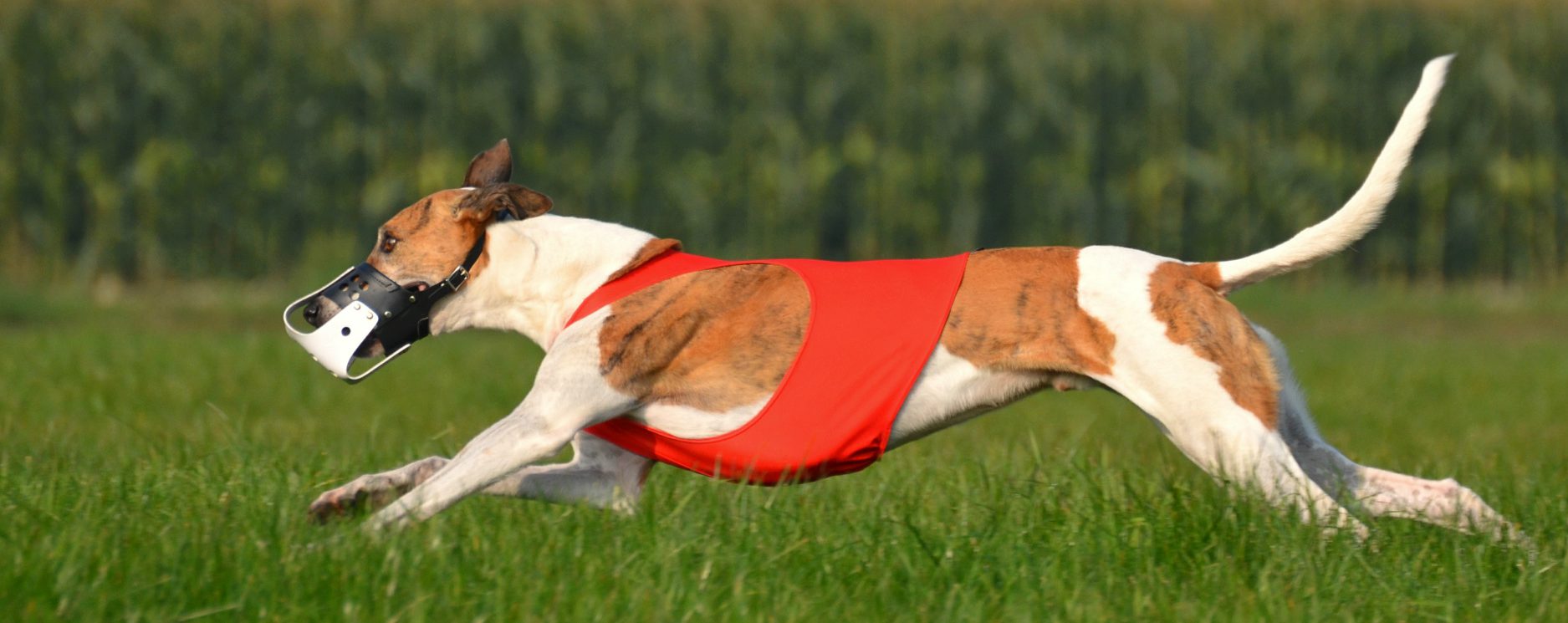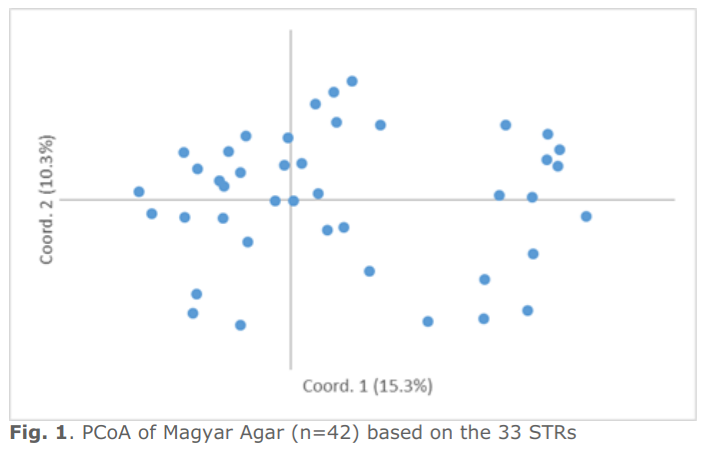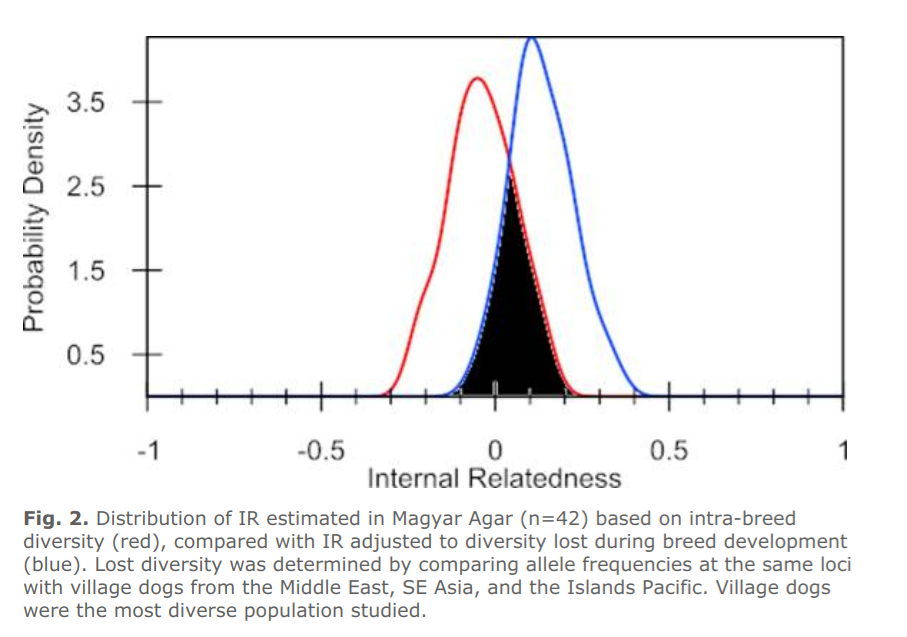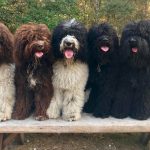
Magyar Agár- initial report!
UC Davis released this week initial results for the breed Magyar Agár. This is a very old breed, which originated 1000 years ago by possibly interbreeding of Oriental Greyhounds and Borzoi in the region of the world now encompassing Hungary. Much later, Greyhounds were bred in to increase speed of the breed. They have thus far done a great job maintaining diversity and randomly breeding. Based on the initial 42 dogs sampled, you can read the initial breed analysis here.
Inbreeding – how genetically similar are the parents of typical Magyar Agár?
 Dr. Pedersen found the following in terms of the inbreeding values of this population:
Dr. Pedersen found the following in terms of the inbreeding values of this population:
Mean IR scores for the 42 Magyar agár ranged from a low of -0.224 (most outbred or parents least related) to a high of 0.150 (most inbred or parents most related), with a mean (average) value of -0.039. One-fourth of the dogs had IR scores from -0.106 to -0.224 and were more outbred than the average. Conversely, one-fourth ranged from 0.029 to 0.150 and were more inbred. Therefore, even though the standard genetic assessment indicated that this group of dogs was from a randomly breeding population, one quarter of the individuals were more outbred than indicated and one-fourth more inbred.
Interpretation? Based on the dogs thus far tested, this breed has been doing a good job reducing inbreeding within the population, with a small segment of the population nearing high inbreeding levels. This finding may change as more of the population is sampled.
Breedwide diversity
Biodiversity and allelic richness are terms we try to discuss regularly at BetterBred. Namely, how many different versions of genes or alleles exist in each breed? Breeds with more allelic richness and whose genetics are also well distributed throughout the population tend to be healthier. So what did they find about the Magyar Agár population?
From the report: “All the dogs tested belonged to a single cluster (breed) but with a moderate degree of genetic drift between individuals (Fig. 1). This pattern is consistent with a population that has reasonable degree of phenotypic and therefore genotypic diversity. ” This means that when a breeder is looking for a mate that will compliment their dog/bitch genetically, that there would be a lot of unrelated dogs to choose from, as the breed does not appear to have a genetic cluster (or bottleneck).
But what about biodiversity or allelic richness? Of the thus far tested Magyar Agár, UC Davis has found that they have moderate to low diversity in comparison to other tested breeds. This number may change as more of the breed is tested.
Average alleles per locus and effective alleles per locus are aspects that we discuss in these breed reports. The closer the effective alleles (we call these “alleles that are effectively contributing to your population”) are to the average alleles per locus, the better distributed the genetics in the breed are. Why would you want well distributed genetics? It keeps risk of unwanted recessive traits from appearing, lowers risk of random loss of diversity (called genetic drift) and it lowers the frequency of both simple and complex disease haplotypes that might unintentionally become more common if there were a bottleneck. The average alleles per locus in this breed was found to be 6.394, while the effective alleles per locus was found to be 3.592.
Each breed should make an effort to raise their effective alleles per locus. How do you do this? You use BetterBred’s breed management software to breed for higher than breed average Outlier Index (OI). This measurement was created to help breed communities maintain healthy distribution of breed genetics or redistribute unbalanced diversity, even while they select for the traits they want in their dogs.
Diversity compared to village dogs
 Dr. Pedersen’s hallmark comparison is to a combined population of village dogs. These domestic dogs have not been shaped by human effort, but instead have evolved through random breeding and natural selection. They therefore have a great amount of genetic diversity which is representative of the original diversity dogs had prior to modern breeding methods which changed them. Dr Pedersen therefore assesses the IR results based on only their own genetic data and compares them to their results using the village dog genetics – called IRVD. The difference between these two results illustrates the diversity that has been lost in each modern breed.
Dr. Pedersen’s hallmark comparison is to a combined population of village dogs. These domestic dogs have not been shaped by human effort, but instead have evolved through random breeding and natural selection. They therefore have a great amount of genetic diversity which is representative of the original diversity dogs had prior to modern breeding methods which changed them. Dr Pedersen therefore assesses the IR results based on only their own genetic data and compares them to their results using the village dog genetics – called IRVD. The difference between these two results illustrates the diversity that has been lost in each modern breed.
From the report:
A rough estimate based on areas under the curve (black), indicates that Magyar agár possess 39% of the genetic diversity still present in all dogs. If 39% of available genetic diversity has been retained, 61% has been lost.The retention of 39% of known genetic diversity is average when compared to other breeds. For instance, the Swedish Vallhund has retained only 7% of canine genetic diversity, the Doberman Pinscher 15% and the Shiloh Shepherd 27%, while at the highest level the Miniature Poodle has retained 51%, the Golden Retriever 50.4% in Labrador retriever 54%, and Toy Poodle 60%.
Translation? Same as above, Magyar Agár have maintained a moderate amount of biodiversity in comparison to the other tested breeds to date. This number may increase as more of this population is tested.
DLA – Dog Leukocyte Antigen
A Look at the Dog’s Immune System!
There have been a relatively large amount of DLA haplotypes found in this population of 42 tested Magyar Agár with 12 DLA class I and 6 DLA class II haplotypes discovered. This is slightly less than other breeds with similar biodiversity at the breedwide level like Giant Schnauzers, American Akitas, Black Russian Terriers and Shiba Inus. However, as more of this population is tested, more diversity in the DLA region may be found.
From the report:
Class I haplotypes 1161-1164 are unique to this point to Magyar agar and were found in 26% of the dogs, while the rest of the class I haplotypes and all of the class II haplotypes have been recognized in other breeds.
It will be interesting to see if breeds like the Borzoi and Greyhound will share these DLA haplotypes with the Magyar Agár. Interesting, unlike many breeds, there are not specific Class 1 and Class 2 DLA haplotypes that are carried by the majority of the population. This may be another effect of them randomly breeding and not tending to inbreed. You can read more about using DLA in a breeding program here.
The breed report also noted the following:
DLA class I haplotype sharing based on both numbers and frequency of occurrence was seen between Labrador, Golden and Flat Coated Retrievers; Shiloh shepherd, Miniature and Standard Poodles, Havanese, Shiba Inu and Italian greyhound. DLA class II haplotype sharing was also with Miniature and Standard Poodles, Havanese, Shiloh Shepherds, Golden retriever and Shiba Inu, in addition to the Toy Poodle, Japanese and American Akita, and Giant Schnauzer. This extensive sharing of DLA haplotypes with other breeds indicates that Magyar agár were derived from many common ancestors.
It is always interesting to see what haplotypes are shared among breeds, as it can inform on the ancient origins of the breeds.
Conclusion
From Dr. Pedersen’s report:
The findings that Magyar agar have retained a fair amount of genetic diversity during breed evolution, and breeder’s success in avoiding inbreeding, may explain the comparatively good health of the breed. Only one genetic disorder (i.e., PRA) of presumed Mendelian inheritance has been recognized in the breed at low frequency, which also reflects the both the favorable genetic diversity and health of the founding population and strict adherence to random breeding and avoidance of artificial genetic bottlenecks such as popular sire effect. However, the occurrence of hypothyroidism and epilepsy in the breed are warning signs of low genetic diversity and excessive inbreeding. Therefore, it will be critical for breeders to maintain existing genetic diversity, continually breed away from heritable disorders whether simple or complex and avoid artificial genetic bottlenecks.
This breed has thus far been found to have average diversity comparative to other breeds, and more may be discovered as more dogs are tested. It is vital to maintain what has thus far found within the breed.
Our Recommendation
Since the Magyar Agár breeders have thus far done a good job not inbreeding, our recommendation is to work to maintain the biodiversity that has been maintained at the breedwide level. This is thus far a moderate to low level of biodiversity, but more may be found as more of the breed is sampled. Our software can help with this by breeding for higher than breed average OI and lower than breed average AGR.

 Previous Post
Previous Post Next Post
Next Post


